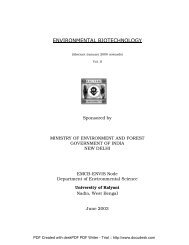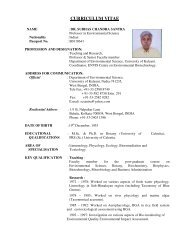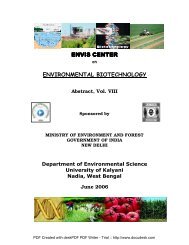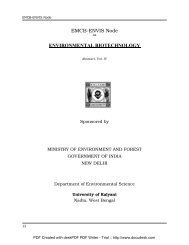EMCB-ENVIS Node ENVIRONMENTAL BIOTECHNOLOGY
EMCB-ENVIS Node ENVIRONMENTAL BIOTECHNOLOGY
EMCB-ENVIS Node ENVIRONMENTAL BIOTECHNOLOGY
Create successful ePaper yourself
Turn your PDF publications into a flip-book with our unique Google optimized e-Paper software.
<strong>EMCB</strong>-<strong>ENVIS</strong> Centre<br />
phenanthrene) and uninduced Phase II mushroom composts were equally able to promote<br />
degradation of this soil-associated contaminant. After 111 days incubation time, 42.7±6.3% loss<br />
of soil-associated phenanthrene was observed in the induced-compost soil mixture, while<br />
36.7±2.9% loss of soil-associated phenanthrene was observed in the uninduced-compost soil<br />
mixture. These results are notable as they indicate that while pre-induction of phenanthrenecatabolism<br />
within compost is possible, it does not significantly increase the extent of degradation<br />
when the compost is used to ameliorate phenanthrene-contaminated soil. Thus, compost could be<br />
used directly in the amelioration of contaminated land i.e. without pre-induction of catabolism.<br />
C. D. Johnston, A. Desvignes. (CSIRO Land and Water, Private Bag 5, PO Wembley, W.A.,<br />
6913, Australia. Hydrogeology Centre of the University of Neuchâtel, Neuchâtel,<br />
Switzerland). Evidence for biodegradation and volatilisation of dissolved petroleum<br />
hydrocarbons during in situ air sparging in large laboratory columns. Water, Air and<br />
Soil Pollution: Focus, 3(3) (2003), 25-33.<br />
Laboratory column experiments run for up to 13 days compared air sparging of groundwater<br />
contaminated by dissolved petroleum hydrocarbons in sterile and non-sterile aquifer sediments<br />
as well as uncontaminated sediments and groundwater. Loss of dissolved BTEX compounds in<br />
the contaminated columns was very rapid, occurring through volatilisation. The majority of the<br />
dissolved total organic carbon (TOC) persisted for much longer periods however. A direct<br />
comparison between losses from sterile and non-sterile columns suggested a negligible<br />
contribution of biodegradation to the removal of TOC. This was difficult to confirm through<br />
examination of O2 utilisation because oxidation of a small amount of reduced sulphur in the<br />
aquifer materials was the dominant sink for O2. Despite this, it was possible to conclude that less<br />
than 22% of the removal of TOC was through biodegradation during the first three days of air<br />
sparging.<br />
D. Y. Kim, Y. H. Rhee. (Department of Microbiology, Chungnam National University, 305-<br />
764, Daejeon, Korea). Biodegradation of microbial and synthetic polyesters by fungi.<br />
Applied Microbiology and Biotechnology, 61(4) (2003), 300 – 308.<br />
A variety of biodegradable polyesters have been developed in order to obtain useful biomaterials<br />
and to reduce the impact of environmental pollution caused by the large-scale accumulation of<br />
non-degradable waste plastics. Polyhydroxyalkanoates, poly(k-caprolactone), poly(l-lactide), and<br />
both aliphatic and aromatic polyalkylene dicarboxylic acids are examples of biodegradable<br />
polyesters. In general, most aliphatic polyesters are readily mineralized by a number of aerobic<br />
and anaerobic microorganisms that are widely distributed in nature. However, aromatic<br />
polyesters are more resistant to microbial attack than aliphatic polyesters. The fungal biomass in<br />
soils generally exceeds the bacterial biomass and thus it is likely that fungi may play a<br />
considerable role in degrading polyesters, just as they predominantly perform the decomposition<br />
of organic matter in the soil ecosystem. However, in contrast to bacterial polyester degradation,<br />
which has been extensively investigated, the microbiological and environmental aspects of<br />
fungal degradation of polyesters are unclear. This review reports recent advances in our<br />
knowledge of the fungal degradation of microbial and synthetic polyesters and discusses the<br />
ecological importance and contribution of fungi in the biological recycling of waste polymeric<br />
materials in the biosphere.<br />
David Schleheck, Melanie Lechner, René Schönenberger, Marc J.-F. Suter, Alasdair M. Cook.<br />
(Department of Biology, The University of Konstanz, D-78457 Konstanz, Germany, Swiss<br />
Federal Institute for Environmental Science and Technology, CH-8600 Dübendorf, Switzerland).<br />
Desulfonation and Degradation of the Disulfodiphenylethercarboxylates<br />
from Linear Alkyldiphenyletherdisulfonate Surfactants.Applied and Environmental<br />
Microbiology, February, 69(2) (2003), 938-944.<br />
52<br />
PDF Created with deskPDF PDF Writer - Trial :: http://www.docudesk.com







